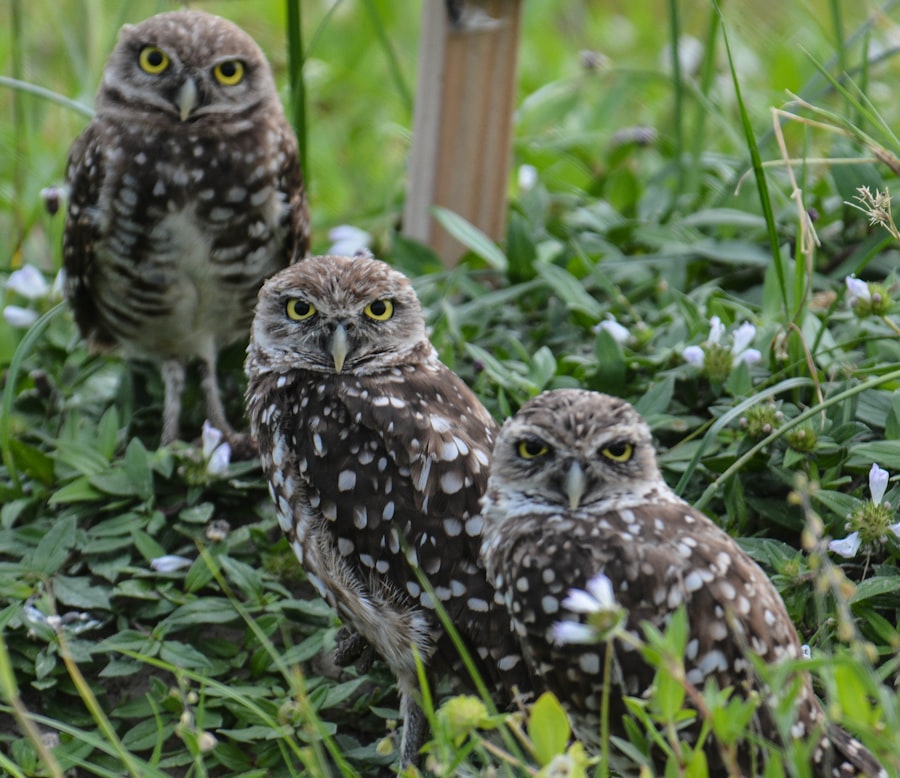Owls are nocturnal birds of prey known for their exceptional hunting abilities. Their specialized feathers enable silent flight, allowing them to approach prey undetected. Owls possess superior vision and hearing, which contribute to their hunting efficiency.
A notable feature is their ability to rotate their heads up to 270 degrees, providing a wide field of view without moving their bodies. These adaptations make owls highly effective predators in their natural habitats. As opportunistic hunters, owls consume a diverse diet including small mammals, birds, and insects.
They are attracted to areas with plentiful food sources, which can include chicken coops. When owls target chickens, they are acting on their innate predatory instincts. Understanding owl behavior is crucial for chicken owners seeking to protect their flocks from potential attacks.
Owls are territorial animals and may perceive chicken coops as intrusions into their domain. This territorial behavior can result in repeated attacks on chicken coops as owls attempt to eliminate perceived threats. Recognizing the territorial nature of owls can assist chicken owners in implementing effective deterrent measures to safeguard their flocks.
Table of Contents
- 1 Implementing Protective Measures for Chickens
- 2 Providing Secure Housing for Chickens
- 3 Using Deterrents to Keep Owls Away
- 4 Creating a Well-Lit Environment
- 5 Keeping Chickens Safe During Nighttime
- 6 Seeking Professional Assistance if Necessary
- 7 FAQs
- 7.1 What are some effective methods for keeping owls from killing chickens?
- 7.2 Are there any natural deterrents for keeping owls away from chickens?
- 7.3 What are some ways to secure the chicken coop to prevent owl attacks?
- 7.4 Are there any legal methods for deterring owls from attacking chickens?
- 7.5 What should I do if an owl continues to attack my chickens despite my efforts to deter it?
Key Takeaways
- Owls are nocturnal predators and are attracted to areas with abundant food sources, such as chicken coops.
- Implementing protective measures for chickens, such as using secure fencing and covering the coop with wire mesh, can help prevent owl attacks.
- Providing secure housing for chickens, such as sturdy and well-ventilated coops, can help protect them from owl attacks.
- Using deterrents like motion-activated lights, noise machines, and reflective tape can help keep owls away from chicken coops.
- Creating a well-lit environment around the chicken coop can help deter owls from approaching and attacking the chickens during nighttime.
- Keeping chickens safe during nighttime by securely locking them in their coop and ensuring all entry points are sealed can help prevent owl attacks.
- Seeking professional assistance, such as consulting with wildlife experts or hiring pest control services, can be necessary if owl attacks on chickens persist despite protective measures.
Implementing Protective Measures for Chickens
Secure Shelter and Fencing
Protecting chickens from owl attacks requires a proactive approach that addresses the specific vulnerabilities of the coop and its inhabitants. One effective measure is to provide adequate shelter for the chickens, such as secure fencing and a sturdy coop with a solid roof. This can help prevent owls from gaining easy access to the chickens and reduce the risk of attacks.
Deterrents and Supervision
Additionally, installing motion-activated lights or alarms around the coop can startle owls and deter them from approaching. Another protective measure is to supervise the chickens during their free-range time, especially during dawn and dusk when owls are most active. By keeping a watchful eye on the flock during these vulnerable times, chicken owners can intervene quickly if an owl is spotted nearby.
Providing Safe Havens and Observing Chicken Behavior
Additionally, providing hiding spots and shelters within the chicken run can give the birds a safe place to retreat if they sense danger from above. It’s also important to consider the behavior of the chickens themselves when implementing protective measures. Chickens are naturally wary of predators and will often seek cover when they sense danger. By observing their behavior and responding to their cues, chicken owners can better understand how to protect them from potential owl attacks.
Providing Secure Housing for Chickens

Creating a secure housing environment for chickens is essential for protecting them from owl attacks. This includes ensuring that the coop is well-built and free from any potential entry points for owls. Checking for gaps or holes in the coop’s structure and promptly repairing any damage can help prevent owls from gaining access to the chickens.
In addition to securing the physical structure of the coop, it’s important to provide adequate roosting options for the chickens. Roosting bars should be placed at a height that is difficult for owls to reach, ideally within an enclosed area of the coop. This can help keep the chickens safe from potential attacks while they are roosting at night.
Furthermore, providing a secure outdoor run for the chickens can give them a safe space to roam during the day while still being protected from owl attacks. The run should be covered with wire mesh or netting to prevent owls from swooping down and grabbing the chickens. By creating a secure housing environment for the chickens, chicken owners can significantly reduce the risk of owl attacks and ensure the safety of their flock.
Using Deterrents to Keep Owls Away
Implementing deterrents is an effective way to keep owls away from chicken coops and protect the flock from potential attacks. One common deterrent is the use of visual deterrents, such as reflective tape or shiny objects that can startle and deter owls from approaching. These visual deterrents can be hung around the coop or run to create a barrier that discourages owls from getting too close.
Another effective deterrent is the use of sound devices that emit noises that are unpleasant or frightening to owls. These devices can include ultrasonic emitters or recordings of predator calls that can deter owls from approaching the coop. By using sound deterrents, chicken owners can create an environment that is less appealing to owls and reduce the risk of attacks on their flock.
Additionally, employing natural deterrents such as predator decoys or scent-based repellents can help keep owls away from chicken coops. Placing decoys of larger birds of prey near the coop can create the illusion of a potential threat to owls, deterring them from approaching. Scent-based repellents, such as predator urine or essential oils with strong odors, can also discourage owls from targeting the chickens.
By using a combination of visual, sound, and natural deterrents, chicken owners can create a protective barrier around their coop that discourages owls from targeting their flock. It’s important to regularly rotate and change deterrent methods to prevent owls from becoming accustomed to them and finding ways to bypass them.
Creating a Well-Lit Environment
Creating a well-lit environment around the chicken coop can help deter owls from approaching and reduce the risk of attacks on the flock. Owls are nocturnal hunters and prefer to operate in low-light conditions, making well-lit areas less appealing to them. By installing motion-activated lights around the coop and run, chicken owners can create a bright environment that makes it difficult for owls to approach undetected.
In addition to motion-activated lights, keeping the area around the coop clear of dense vegetation and clutter can help improve visibility and reduce hiding spots for owls. This open environment makes it easier for chicken owners to monitor for potential owl activity and intervene if necessary. By creating a well-lit environment, chicken owners can significantly reduce the risk of owl attacks on their flock.
Keeping Chickens Safe During Nighttime

Securing the Coop at Night
Nighttime poses a heightened risk for owl attacks on chicken coops, making it essential for chicken owners to take extra precautions to keep their flock safe during this vulnerable time. One effective measure is to ensure that all chickens are securely locked inside the coop at night, with no access to outdoor areas where they could be targeted by owls. This can be achieved by installing automatic coop doors or manually securing all entry points before nightfall.
Providing Safe Roosting Options
Another important consideration is providing adequate roosting options within the coop that are difficult for owls to access. Placing roosting bars at varying heights and within enclosed areas of the coop can give chickens safe places to rest at night without being vulnerable to owl attacks. Additionally, providing nesting boxes with secure entrances can give hens a safe place to lay eggs without being targeted by owls.
Vigilance During Nighttime Hours
It’s also important for chicken owners to be vigilant during nighttime hours and listen for any signs of owl activity near the coop. Owls are known for their distinctive calls, which can serve as an early warning sign of potential danger. By staying alert and responding quickly to any signs of owl activity, chicken owners can help keep their flock safe during nighttime hours.
Seeking Professional Assistance if Necessary
In some cases, despite best efforts, owl attacks on chicken coops may persist, posing a significant threat to the safety of the flock. In such situations, it may be necessary for chicken owners to seek professional assistance from wildlife experts or pest control professionals who specialize in managing owl conflicts. Professional assistance can involve conducting a thorough assessment of the property and coop to identify potential vulnerabilities that may be attracting owls.
Wildlife experts can provide valuable insights and recommendations for implementing effective deterrents and protective measures tailored to the specific needs of the property and flock. Additionally, pest control professionals may offer humane trapping and relocation services for problem owls that pose a persistent threat to chickens. These professionals have the expertise and resources to safely capture and relocate problematic owls away from the property, reducing the risk of further attacks on the flock.
By seeking professional assistance when necessary, chicken owners can access specialized knowledge and resources that can help effectively manage owl conflicts and protect their flock from potential harm. In conclusion, understanding owl behavior is crucial for implementing protective measures for chickens. By creating secure housing environments, using deterrents, creating well-lit environments, and keeping chickens safe during nighttime hours, chicken owners can significantly reduce the risk of owl attacks on their flock.
Seeking professional assistance when necessary can provide valuable support in managing owl conflicts and protecting chickens from harm. With proactive measures in place, chicken owners can create a safe and secure environment for their flock while coexisting peacefully with these fascinating nocturnal predators.
If you’re looking for more information on keeping chickens safe, you might be interested in this article on 10 essential features for a chicken coop. It provides valuable tips on how to create a secure and comfortable environment for your chickens, which can also help prevent owl attacks.
FAQs
What are some effective methods for keeping owls from killing chickens?
Some effective methods for keeping owls from killing chickens include using motion-activated lights, placing reflective objects in the chicken coop, and using scare tactics such as loud noises or predator decoys.
Are there any natural deterrents for keeping owls away from chickens?
Yes, some natural deterrents for keeping owls away from chickens include planting dense shrubs or trees around the chicken coop to provide cover for the chickens, and using roosters to help protect the flock.
What are some ways to secure the chicken coop to prevent owl attacks?
Securing the chicken coop to prevent owl attacks can be done by using hardware cloth to cover windows and vents, installing an electric fence around the perimeter of the coop, and ensuring that the coop is securely locked at night.
Are there any legal methods for deterring owls from attacking chickens?
Yes, there are legal methods for deterring owls from attacking chickens, such as obtaining a permit to use non-lethal control methods, and following local and federal regulations regarding the protection of owls.
What should I do if an owl continues to attack my chickens despite my efforts to deter it?
If an owl continues to attack your chickens despite your efforts to deter it, you should contact a wildlife conservation organization or a licensed wildlife control professional for assistance in safely and humanely addressing the issue.
Meet Walter, the feathered-friend fanatic of Florida! Nestled in the sunshine state, Walter struts through life with his feathered companions, clucking his way to happiness. With a coop that’s fancier than a five-star hotel, he’s the Don Juan of the chicken world. When he’s not teaching his hens to do the cha-cha, you’ll find him in a heated debate with his prized rooster, Sir Clucks-a-Lot. Walter’s poultry passion is no yolk; he’s the sunny-side-up guy you never knew you needed in your flock of friends!







